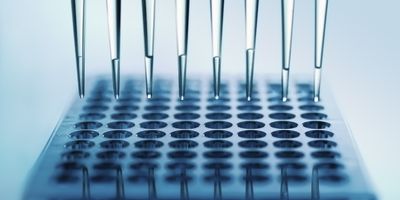Incorporating the Right Pump into Your Liquid Handling System
When choosing a pump, consider workflow, sample, and material
Automated liquid handling is indispensable to biomedical workflows. Evolving technologies like next generation sequencing, flow cytometry, and surface plasmon resonance require. The ability to transfer broad ranges of volumes and incorporate liquids with disparate chemical and physical properties while achieving repetition, precision, and reproducibility. Human hands cannot approach such precision or consistency, making the liquid handler essential to the modern lab.
Syringe pumps, however, are the most versatile and are commonly used as OEM components in liquid handling systems.
When considering the purchase of a new liquid handler, the buyer often sees a fully integrated and seamless machine. However, beyond the windowed box and robot arm, the components that form its guts—pumps, valves, fittings, tubing—are often supplied by multiple different manufacturers and assembled as an original equipment manufacturer (OEM) product. Potential incompatibilities between these components means that it’s up to buyers to assess their needs and find the right parts for their applications. What follows is a brief primer on choosing the workhorse of the liquid handler: the pump.
Comparing types of pumps
Because liquid is incompressible, many pumps use positive displacement to move it. This allows flow rates to remain constant regardless of fluctuations in system pressure, surface tension, liquid viscosity, and external humidity. Because handlers can cycle through thousands of small-volume liquid distributions per day, many pumps use micro-stepper motors that complete tiny partial rotational angles with every step, continuously delivering nanoscale fluids hundreds of times per full revolution.
Syringe, piston, and peristaltic pumps can all satisfy these conditions. Syringe pumps, however, are the most versatile and are commonly used as OEM components in liquid handling systems. This is because of their ability to handle multiple liquid or positive-pressure injection sources within a single workflow, while maintaining reproducible and constant flow rates. These parameters fit well with precision, small-volume workflows for microfluidics, flow cytometry, and chromatography.
A piston pump is often a better option for single-liquid workflows in which pump construction material can be optimally matched to liquid salinity, acidity, and/or causticity. These constraints may pertain best to workflows that are also under constant flow rates but with less variability, such as perfusions, microdialyses, and certain high-throughput screens.
Beyond considering pump technology, purchasers should also assess the details of anticipated workflows to choose the best pump construction materials.
A peristaltic pump operates similarly to physiological digestion. These pumps use rollers to cyclically compress flexible tubing and allow liquid flow upon release, much like how humans swallow. Liquid only contacts the inside of tubing, obviating compatibility concerns with valves, o-rings, and other connectors. However, the requirement for elastomeric tubing to remain pliable across millions of cycles limits the menu of acceptable tubing material and of chemically compatible fluids. Separately, membrane or diaphragm pumps can quickly dispense hundreds of milliliters of bulk liquids per minute through fixed tips, making them more appropriate for priming and plate-washing applications preparatory or subsequent to experimental workflows.
Ensuring chemical compatibility
Beyond considering pump technology, purchasers should also assess the details of anticipated workflows to choose the best pump construction materials. This extends beyond the chemical properties of liquids to their specific formulations, molarities, the solvents in which chemicals are dissolved, and operating conditions, including the temperatures and pressures under which they will be dispensed or aspirated. All of these factors will impact the function, efficiency, and lifespan of pumps and their ancillary valves and fittings. For instance, ceramics can accommodate detergents at elevated temperatures better than stainless steel, while the extra molybdenum in 316 stainless steel confers better resistance to high salinity compared to 304 stainless steel. A good place to start your discovery process is with a chemical compatibility guide.
Here are some additional considerations to address when choosing pump details for a liquid handler:
- High-viscosity liquids require slow pump speeds and the ability to operate within appropriate pressure ranges, often with dwell cycles, priming, or washing steps.
- Syringe pumps with smaller capacities are the most accurate option for distributing small volumes, but when performing many cycles, a larger volume syringe that can aliquot may be more efficient. However, syringe volume should not exceed 100 times the smallest volume that is dispensed.
- The conductivity of your liquid of interest, the vessel from and into which it is dispensed, and the potential for cross- or carry-over contamination are all important considerations that drive decisions for pump technology and materials as well as for consumable (tips, receptacles, etc.) compatibility.
For most laboratories, a liquid handler is a significant purchase, albeit an increasingly necessary one. Moreover, the opportunity to mix and match different OEM components can be bewildering. Because the pump must operate across millions of cycles, buyers should carefully consider how its chemical, operational, and material compatibilities factor into current and predicted applications and workflows.

